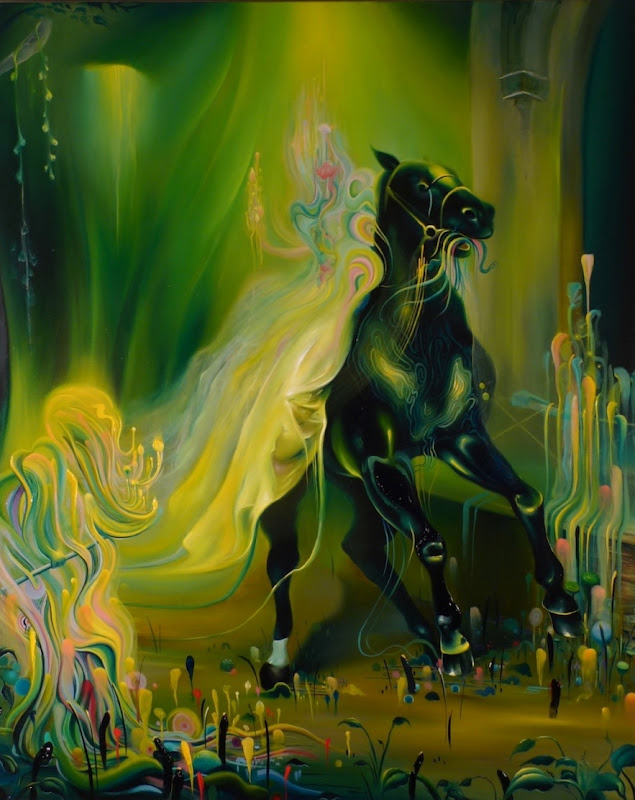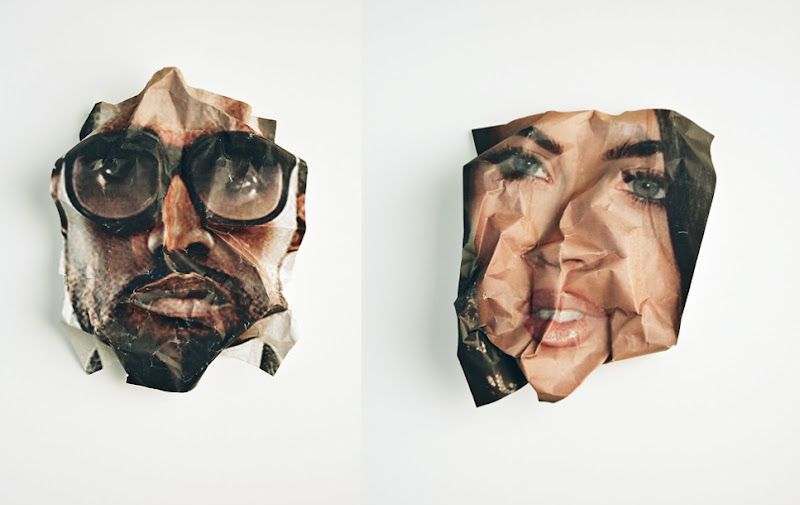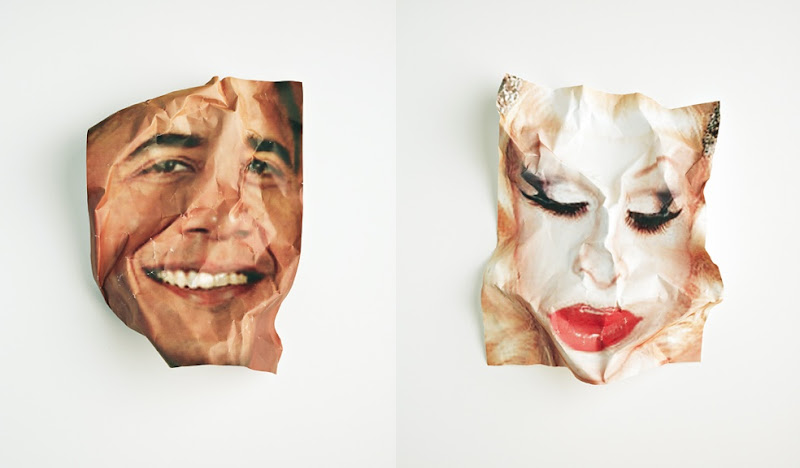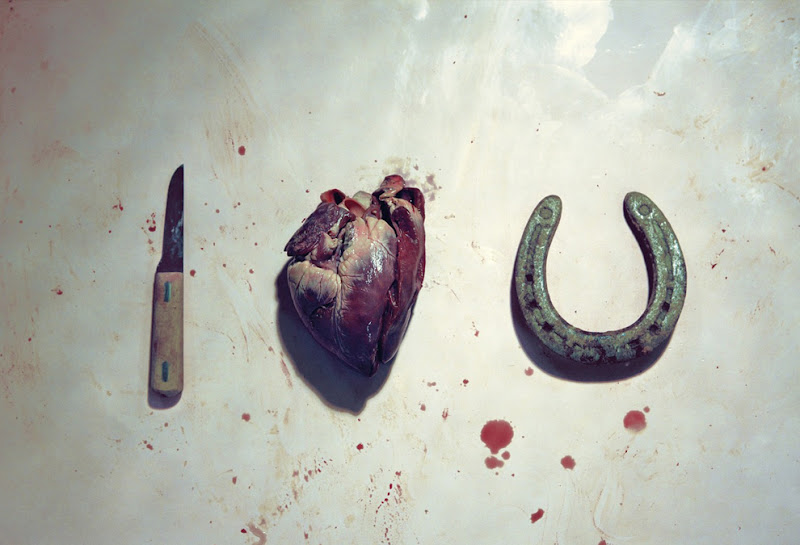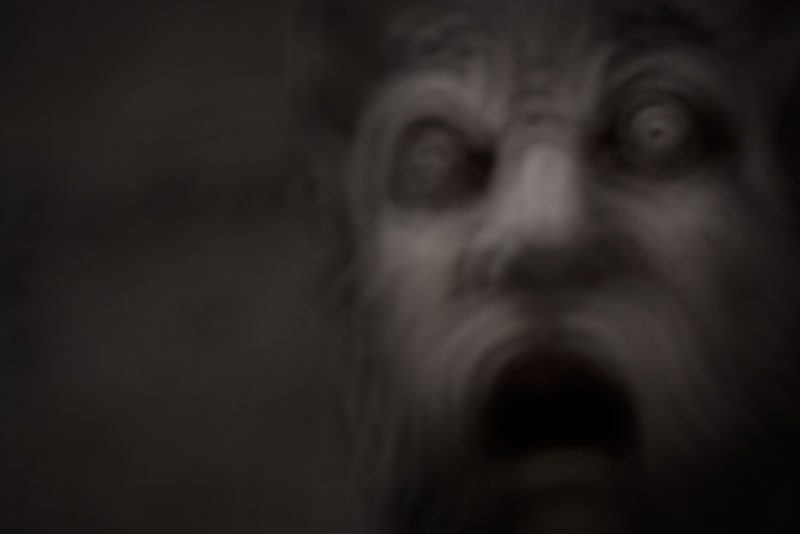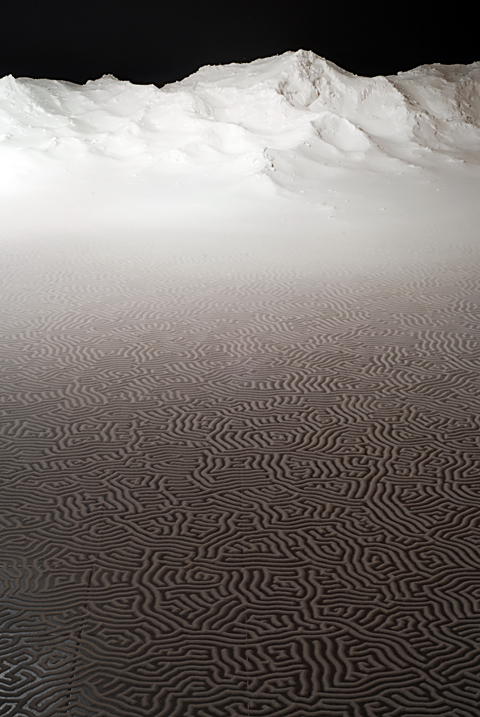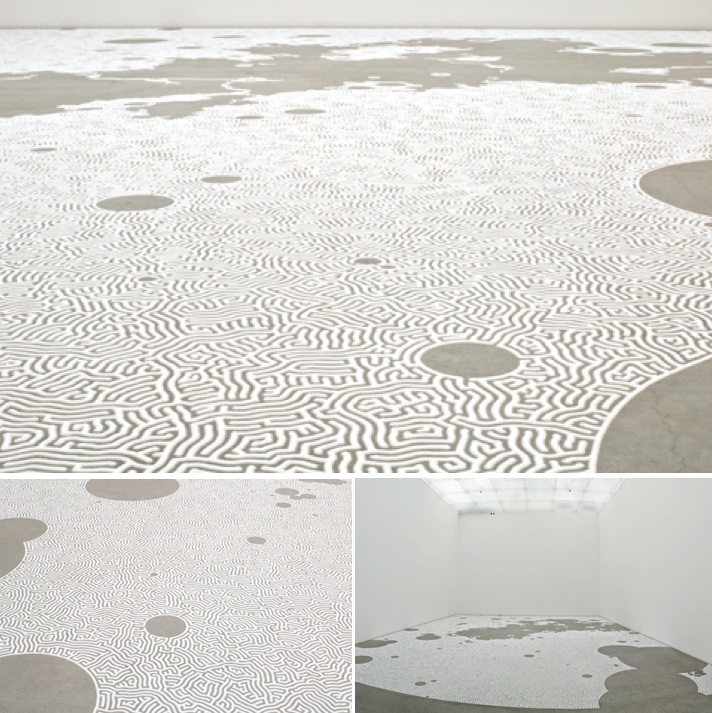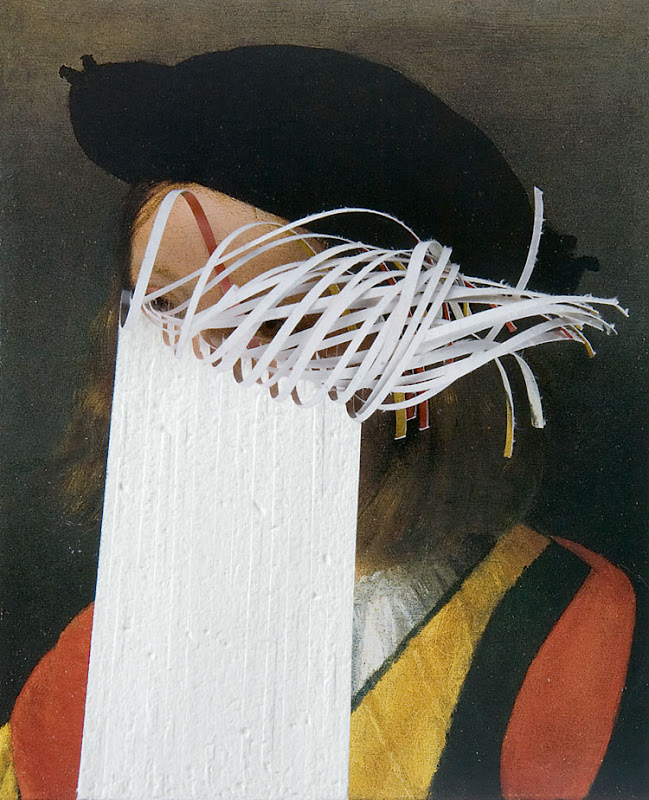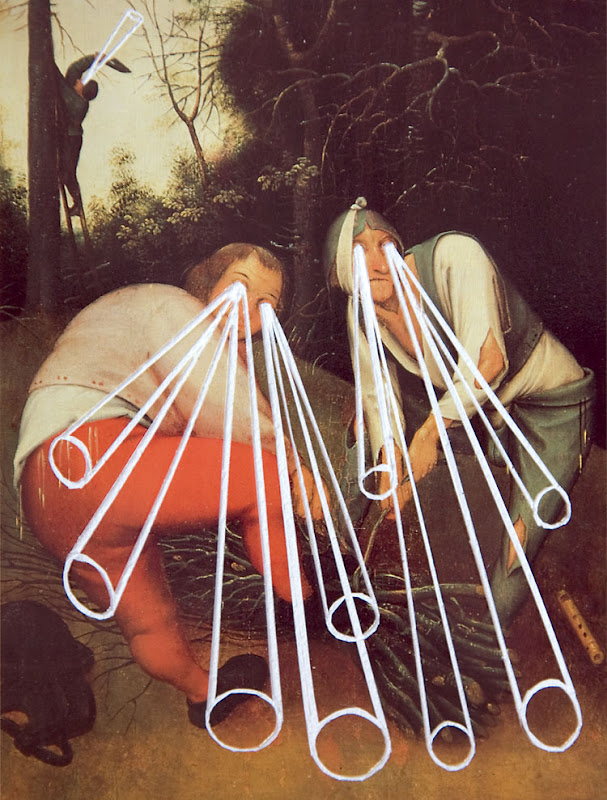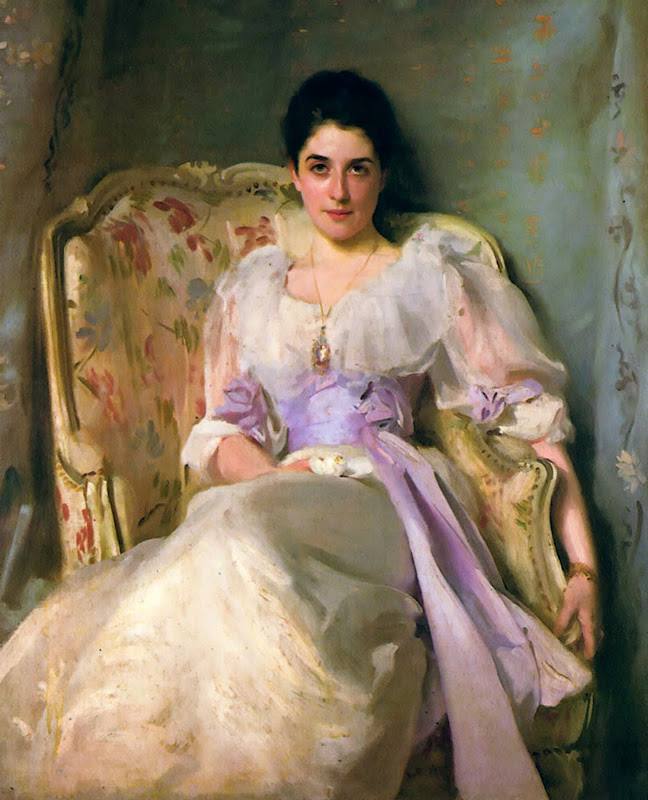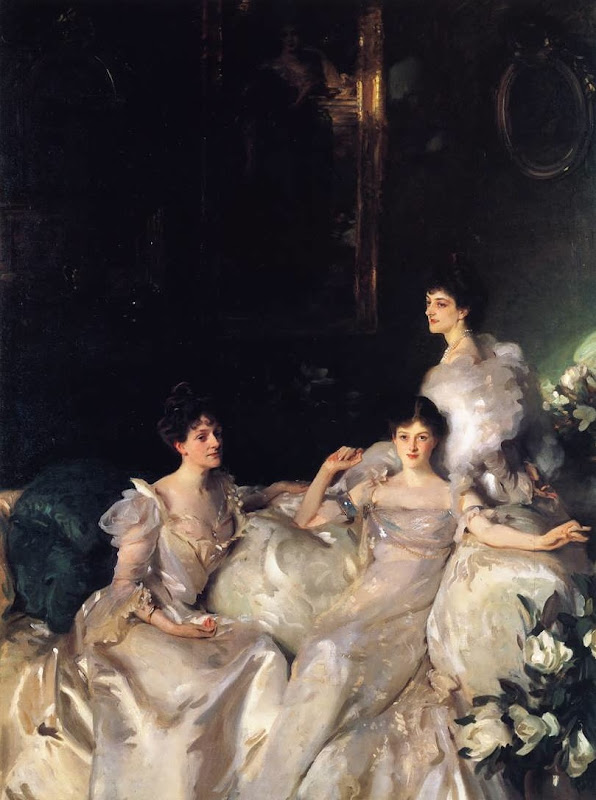Monday 28 February 2011
MICHAEL PAGE
MICHAEL PAGE
Michael Page’s work offers the viewer an optic alternative to the visual reality of life, as we know it. The artist’s characters and organisms inhabit otherworldly realms that are vaguely familiar in their resemblance to our shared reality, but are ultimately their own cosmic manifestation. Narratives of worlds in crisis, such as a self-imposed environmental degradation and the decline of civilization play out across the canvas. His enigmatic imagery is rendered in a rich color palette of swirling and flowing shapes and line that create dynamic movement. The resulting liveliness of the work assists in aiding the viewer’s suspension of disbelief when contemplating the fantastical realities of the artist’s imagination.
☁ MICHAEL PAGE
☁ MICHAEL PAGE @ SHOOTING GALLERY
Friday 25 February 2011
JOSHUA SCOTT
JOSHUA SCOTT /// POPFACES
Funny how even when the faces are all squished up and therefore completely different, we can still recognize the people pictured. The brain really is the master of face recognition! It would be interesting to see how far a picture needs to get crumbled for us not to be able to recognize the faces anymore...
☁ JOSHUA SCOTT
☁ JOSHUA SCOTT @ ICON_OLOGY
Wednesday 23 February 2011
MAURIZIO CATTELAN
MAURIZIO CATTELAN /// REFLECTIONS IN HIS EYES
☁ MAURIZIO CATTELAN
☁ MAURIZIO CATTELAN PREVIOUSLY ON LE ZÈBRE
Sunday 20 February 2011
PETER VAN STRALEN
PETER VAN STRALEN
Peter van Stralen has a deep admiration for female dancers, since they are able to combine power with grace in a very natural way.
Over the last couple of years, many female dancers have participated in his photo projects, especially dancers from the local Dance Academy as well as from the Introdans company, both in Arnhem, The Netherlands. This interaction between these young women on the one hand and his own (photo-)graphic background on the other hand has proven to be most fruitful: "I am deeply indebted to the dancers for all their efforts and their inspiration which they have given to me during countless photographic sessions. Therefore, I do not consider these images just to be mine, but also ours."
Having published his photo book FIGUREN in 2001, Peter van Stralen has tried to create even stranger images of the female body than was the case in FIGUREN. The photographs from this new series he now calls: ODD BODIES.
Unfortunately, ordinary nude photography often shows rather predictable or even banal and degrading images of women. This is why he chose to show female body forms from a somewhat different perspective: neither common nor erotic, but rather strange. To him, women are not just familiar and sensual, but also pleasantly strange and surprising. This series therefore reflects his fascination with women.
☁ PETER VAN STRALEN
☁ PETER VAN STRALEN @ CAMERA OBSCURA
FABIANO BUSDRAGHI
FABIANO BUSDRAGHI /// DEMONS
Demons is a series of photos of the mascarons (grotesque masks) of Pont Neuf in Paris.
Mythology, demonology, folklore and literature, from all around the world and any time, had been used for the demon’s names.
The series of photographs try to explore the relationship between images and feelings, in terms of expressive communication and emotional dialog, exploring the iconography of fear, suffering, malice, sadness, etc. The series is also concerned with the limits between reality and fantasy, how it’s possible that inanimate objects come to life and seem to share the same emotions of human beings. The series is thus a manifestation of the limits of photography to reveal the true essence of reality, when there is only stone we see our nightmares become true.
Finally, one last goal in these photographs, is to rediscover the importance of the fine-art print as an object. For this reason an edition of all the photographs is printed using traditional carbon transfers, perhaps the most difficult and time consuming technique of printing. It is at the same time one of the finest in the history of photography. All the prints are completely hand made, and produced in collaboration with Damiano Bianca, one of the few people who still teach this technique in Italy.
☁ FABIANO BUSDRAGHI
Tuesday 15 February 2011
MOTOI YAMAMOTO
MOTOI YAMAMOTO
Following the death of his sister to brain cancer twelve years ago, MOTOI YAMAMOTO adopted salt as his primary medium. In Japanese culture salt is not only a necessary element to sustain human life, but it is also a symbol of purification. He uses salt in loose form to create intricate labyrinth patterns on the gallery floor or in baked brick form to construct large interior structures. As with the labyrinths and innavigable passageways, Motoi views his installations as exercises which are at once futile yet necessary to his healing.
Salt is a ubiquitous commodity, as it is found in all of the oceans of the world, and virtually all cultures use some variant of it in their diet. What began as an exploration of the practices of Japanese death culture and its use of salt has now become a more philosophical enquiry into the importance of this substance to life on the planet. He likes to think that the salt he uses might have been a life-sustaining substance for some creature. Yamamoto is interested in the interconnectedness of all living things and the fact that salt is something shared by all. For this reason, when his salt-works must be disassembled, he requests that the salt in his installation be returned to the ocean.
A labyrinth may be defined as “a path with a purpose.” There is usually a beginning and an end point. A maze has intentional dead-ends and false starts. On the surface, it would appear that Yamamoto’s works fall into the category of a maze. However, he states that it is his wish that the viewers may use his labyrinth installations as a tool for meditation and an opportunity to reach some final point in their own thoughts. It is interesting to note the similarities between Yamamoto’s drawings and the circuitry of the human brain. Knowing of his sister’s illness, it is not surprising that there is a visual connection between the installations and the source of their inspiration.
According to the artist, “ Drawing a labyrinth with salt is like following a trace of my memory. Memories seem to change and vanish as time goes by. However, what I seek is the way in which I can touch a precious moment in my memories that cannot be attained through pictures or writings. I always silently follow the trace, that is controlled as well as uncontrolled from the start point after I have completed it.” While working on these installations, Yamamoto says that he is only concerned with the “line,” and that the focus of his attention cannot waver from that. When asked about the lack of permanence of his works, the artist states “ It does not matter if the work lasts or does not last. I use salt. It lasts as long as it will.”(SOURCE)
MOTOI YAMAMOTO /// BIO
Born in Onomichi, Hiroshima, Japan in 1966, Motoi Yamamoto worked in a dockyard until he went to school and received his B.A. from Kanazawa College of art in 1995. Since that time, he has had numerous exhibitions and residencies and won many prestigious awards. His works have been exhibited internationally: P.S.1, New York; The 21st Century Museum, Kanazawa, Japan; The Israel Museum, Jerusalem; Maragopoulos, Patras, Greece; Contemporary Art International, Hamburg, Germany; Kunstmuseum, Thun, Switzerland; The Nunnery, London, England; Galleria Vittorio Emanuele, Milano, Italy; Sculpture Garden, Verecruz. Mexico; and many more. He was awarded a grant from The Pollock-Krasner Foundation in 2003, and won the Philip Morris Art Award in 2002.
☁ MOTOI YAMAMOTO
☁ MOTOI YAMAMOTO @ LOST @ E MINOR
Thursday 10 February 2011
RUTH CLAXTON
RUTH CLAXTON /// POSTCARDS SERIES
Taking postcards of historical paintings, Claxton explores the complex nature of ‘the Gaze’ by manipulating the top layer of the card and slicing into its surface to create entirely new artworks which, with their intricate patterns, simultaneously entice and frustrate the viewer. Claxton’s postcards hover in an ambiguous territory between two dimensions and three, the auspicious survivors of a process plagued by inherent failure – one quick slice of the scalpel blade can instantly 'finish' an individual work - in either the best or worst possible sense of the word.
☁ RUTH CLAXTON @ INGLEBY GALLERY
JOHN SINGER SARGENT
I am singing up for classes of Old Masters painting techniques, which has me looking through old Masters paintings, obviously. And I made an amazing discovery, a painter I did not know about. I completely fell in love with his work. The name is JOHN SINGER SARGENT (January 12, 1856 – April 14, 1925), an American painter and a leading portrait painter of his era. During his career, he created roughly 900 oil paintings and more than 2,000 watercolors, as well as countless sketches and charcoal drawings. His oeuvre documents worldwide travel, from Venice to the Tyrol, Corfu, the Middle East, Montana, Maine, and Florida.
Through my reaserch, I fell on this interesting story about one painting he made: THE NOTORIOUS MADAME X (last painting shown up here. And the picture just before is one of Sargent himself with the famous painting).
"When John Singer Sargent was living in France he painted the socialite beauty, Virginie Gautreau. And, when he showed that portrait at the Salon of 1884 he had high hopes of being hailed as the darling of the Parisian artworld.
Virginie was an American who had married a wealthy French banker, and Sargent wrote to a friend at the time – “I have a great desire to paint her portrait and have reason to think she would allow it and is waiting for someone to propose this homage to her beauty. If you are ‘bien avec elle’ and will see her in Paris, you might tell her I am a man of prodigious talent.”
In the June of 1883, the prodigiously talented young man was invited to Virginie’s estate in Brittany where many preparatory sketches were made. For the final portrait, as with that of Ena and Betty Wertheimer, Sargent worked on a very large canvas – almost seven feet (2 meters) tall - hoping that way to ensure the greatest attention.
The result was derision and scandal, and what drew the greatest attention by far was the fact that, in the original painting, one strap of Virginie’s gown was shown as having fallen away, suggesting an air of decadence and sexual availability.
The model thought the work a masterpiece, but her mother demanded it never be shown, and with Salon members so outraged Sargent repainted his model’s gown with the strap being firmly secured on her shoulder. But, the damage was already done, and if he and his model had hoped for acclaim the ensuing reviews were most disappointing. Madame Gautreau's reputation was lost, and even though Sargent withdrew the work and subsequently renamed it as Madame X, such was the affect upon his career he was forced to leave Paris in ignominy to set up a new studio in London – where he soon achieved enormous success.
But, Sargent never lost faith in that portrait of Virginie, once writing that, “I suppose it is the best thing that I have ever done.” He displayed it in various exhibitions and eventually sold it to the American Metropolitan Museum of Art for the sum of $1000.
Another full-sized sketch (shown up here) remains on display in London's Tate Britain - where one of the straps on Virginie’s gown is still salaciously removed." (THIS STORY COMES FROM HERE)
☁ JOHN SINGER SARGENT COMPLETE BIO ON WIKIPEDIA
Subscribe to:
Posts (Atom)


